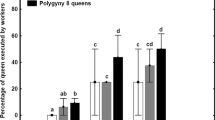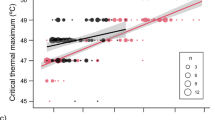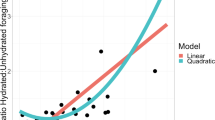Abstract
As small-bodied terrestrial organisms, insects face severe desiccation risks in arid environments, and these risks are increasing under climate change. Here, we investigate the physiological, chemical, and behavioral mechanisms by which harvester ants, one of the most abundant arid-adapted insect groups, cope with desiccating environmental conditions. We aimed to understand how body size, cuticular hydrocarbon profiles, and queen number impact worker desiccation resistance in the facultatively polygynous harvester ant, Pogonomyrmex californicus. We measured survival at 0% humidity of field-collected worker ants sourced from three closely situated populations within a semi-arid region of southern California. These populations vary in queen number, with one population dominated by multi-queen colonies (primary polygyny), one population dominated by single-queen colonies, and one containing an even mix of single- and multi-queen colonies. We found no effect of population on worker survival in desiccation assays, suggesting that queen number does not influence colony desiccation resistance. Across populations, however, body mass and cuticular hydrocarbon profiles significantly predicted desiccation resistance. Larger-bodied workers survived longer in desiccation assays, emphasizing the importance of reduced surface area-to-volume ratios in maintaining water balance. Additionally, we observed a positive relationship between desiccation resistance and the abundance of n-alkanes, supporting previous work that has linked these high-melting point compounds to improved body water conservation. Together, these results contribute to an emerging model explaining the physiological mechanisms of desiccation resistance in insects.




Similar content being viewed by others
Data availability
Data is made available in the supplementary information.
References
Baudier KM, Ostwald MM, Haney BR, Calixto JM, Cossio FJ, Fewell JH (2022) Social factors in heat survival: multiqueen desert ant colonies have higher and more uniform heat tolerance. Physiol Biochem Zool 95(5):379–389. https://doi.org/10.1086/721251
Becker R, Wilks A, Brownrigg R, Minka T, Deckman A (2018) maps: draw geographical maps. R package version 3.3.0.
Bernstein R (1974) Seasonal food abundance and foraging activity in some desert ants. Am Nat 108(962):490–498
Bivand R, Keitt T, Rowlingson B (2021) gdal: bindings for the “Geospatial” data abstraction library. R package version 1.5-23
Blomquist G, Bagnères A (eds) (2010). Cambridge University Press, Cambridge
Bonebrake TC, Mastrandrea MD (2010) Tolerance adaptation and precipitation changes complicate latitudinal patterns of climate change impacts. PNAS 107(28):12581–12586. https://doi.org/10.1073/pnas.0911841107
Boulay R, Quagebeur M, Godziñska EJ, Lenoir A (1999) Social isolation in ants: evidence of its impact on survivorship and behavior in camponotus fellah (Hymenoptera, Formicidae). Sociobiology 33(2):111–124
Bourke A, Franks NR (1995) Social evolution in ants. Princeton University Press
Brandt M, van Wilgenburg E, Sulc R, Shea KJ, Tsutsui ND (2009) The scent of supercolonies: the discovery, synthesis, and behavioural verification of ant colony recognition cues. BMC Biol 7:71. https://doi.org/10.1186/1741-7007-7-71
Brown J, Reichman O, Davidson D (1979) Granivory in desert ecosystems. Ann Rev Ecol Evol Syst 10:201–227
Buellesbach J, Whyte BA, Cash E, Gibson JD, Scheckel KJ, Sandidge R, Tsutsui N (2018) desiccation resistance and micro-climate adaptation: cuticular hydrocarbon signatures of different argentine ant supercolonies across California. J Chem Ecol 44:1101–1114. https://doi.org/10.1007/s10886-018-1029-y
Bujan J, Yanoviak SP, Kaspari M (2016) Desiccation resistance in tropical insects: causes and mechanisms underlying variability in a Panama ant community. Ecol Evol 6(17):6282–6291. https://doi.org/10.1002/ece3.2355
Cahan S (2001) Cooperation and conflict in ant foundress associations: insights from geographical variation. Anim Behav 61(4):819–825. https://doi.org/10.1006/anbe.2000.1671
Cahan S, Fewell J (2004) Division of labor and the evolution of task sharing in queen associations of the harvester ant Pogonomyrmex californicus. Behav Ecol Sociobiol 56(1):9–17. https://doi.org/10.1007/s00265-003-0746-5
Chown SL, Klok C (2003) Water-balance characteristics respond to changes in body size in subantarctic weevils. Physiol Biochem Zool 76(5):634–643. https://doi.org/10.1086/376919
Chown SL, Sørensen JG, Terblanche JS (2011) Water loss in insects: an environmental change perspective. J Insect Physiol 57(8):1070–1084. https://doi.org/10.1016/j.jinsphys.2011.05.004
Chung H (2014) A single gene affects both ecological divergence and mate choice in Drosophila. Science 343:1148. https://doi.org/10.1126/science.1249998
Chung H, Carroll S (2015) Wax, sex and the origin of species: dual roles of insect cuticular hydrocarbons in adaptation and mating. Bioessays. https://doi.org/10.1002/bies.201500014
Clark R, Fewell J (2014) Social dynamics drive selection in cooperative associations of ant queens. Behav Ecol 25(1):117–123. https://doi.org/10.1093/beheco/art093
Cook B, Mankin J, Anchukaitis K (2018) Climate change and drought: from past to future. Curr Clim Change Rep 4:164–179
Ferveur JF, Cortot J, Rihani K, Cobb M, Everaerts C (2018) Desiccation resistance: effect of cuticular hydrocarbons and water content in Drosophila melanogaster adults. PeerJ 2018(2):1–23. https://doi.org/10.7717/peerj.4318
Fick S, Hijmans R (2017) WorldClim 2: New 1 km spatial resolution climate surfaces for global land areas. Int J Climatol 37(12):4302–4315
Fouet C, Gray E, Besansky NJ, Costantini C (2012) Adaptation to aridity in the malaria mosquito Anopheles gambiae: Chromosomal inversion polymorphism and body size influence resistance to desiccation. PLoS ONE. https://doi.org/10.1371/journal.pone.0034841
Fung F, Lopez A, New M (2011) Water availability in + 2 ℃ and + 4 ℃ worlds. Phil Trans R Soc A 369:99–116. https://doi.org/10.1098/rsta.2010.0293
Gibbs A (1998) Water-proofing properties of cuticular. Lipids 482:471–482
Gibbs A (2002) Lipid melting and cuticular permeability: New insights into an old problem. J Insect Physiol 48:391–400
Gibbs A, Pomonis J (1995) Physical properties of insect cuticular hydrocarbons: the effects of chain length, methyl-branching and unsaturation. Comp Biochem Physiol 112B(2):243–249
Greenberg L, Fletcher DJC, Vinson S (1985) Differences in worker size and mound distribution in monogynous and polygynous colonies of the fire ant Solenopsis invicta buren. J Kansas Entomol Soc 58(1):9–18
Hadley N (1994) Water relations of terrestrial arthropods. Academic Press
Haney B, Fewell J (2018) Ecological drivers and reproductive consequences of non-kin cooperation by ant queens. Oecologia 187(3):643–655. https://doi.org/10.1007/s00442-018-4148-9
Haney B, Fewell J, Cole B, Gadau J, Hölldobler B, Rutowski R (2017) Ecological drivers and reproductive consequences of queen cooperation in the california harvester ant Pogonomyrmex californicus. Arizona State University, Arizona
Harvell CD, Mitchell CE, Ward JR, Altizer S, Dobson P, Ostfeld RS, Samuel MD (2002) Climate warming and disease risks for terrestrial and marine biota. Science 296(5576):2158–2162
Heinze J (1993) Life histories of subarctic ants. Arctic 46(4):354–358
Heinze J, Hölldobler B (1994) Ants in the cold. Memorabilia Zoologica 48:99–108
Heinze J, Kellner K, Seal J (2017) Sociality in ants. In: Rubenstein DR, Abbot P (eds) Comparative social evolution. Cambridge University Press, pp 21–49
Herbers J (1986) Ecological genetics of queen number in Leptothorax longospinosus (Hymenoptera: Formicidae). Entomologia Generalis 11:119–123
Hijmans R (2021) raster: geographic data analysis and modeling. R package version 3.4-13
Hoffmann A, Harshman L (1999) Desiccation and starvation resistance in Drosophila: patterns of variation at the species, population and intrapopulation levels. Heredity 83(6):637–643. https://doi.org/10.1046/j.1365-2540.1999.00649.x
Hölldobler B, Wilson E (1990) The ants. Harvard University Press, In the ants
Hood W, Tschinkel W (1990) Desiccation resistance in arboreal and terrestrial ants. Physiol Entomol 15(1):23–35. https://doi.org/10.1111/j.1365-3032.1990.tb00489.x
Johnson R (2000) Water loss in desert ants: Caste variation and the effect of cuticle abrasion. Physiol Entomol 25(1):48–53. https://doi.org/10.1046/j.1365-3032.2000.00170.x
Johnson R (2021) Desiccation limits recruitment in the pleometrotic desert seed-harvester ant Veromessor pergandei. Ecol Evol 11:294–308. https://doi.org/10.1002/ece3.7039
Johnson R, Gibbs AG (2004) Effect of mating stage on water balance, cuticular hydrocarbons and metabolism in the desert harvester ant, Pogonomyrmex barbatus. J Insect Physiol 50(10):943–953. https://doi.org/10.1016/j.jinsphys.2004.07.006
Kærsgaard CW, Holmstrup M, Malte H, Bayley M (2004) The importance of cuticular permeability, osmolyte production and body size for the desiccation resistance of nine species of Collembola. J Insect Physiol 50(1):5–15. https://doi.org/10.1016/j.jinsphys.2003.09.003
Kaspari M, Weiser M (2000) Ant activity along moisture gradients in a Neotropical forest. Biotropica 32(4):703–711. https://doi.org/10.1111/j.1744-7429.2000.tb00518.x
Kellermann V, Hoffmann AA, Overgaard J, Loeschcke V, Sgro CM (2018) Plasticity for desiccation tolerance across Drosophila species is affected by phylogeny and climate in complex ways. Proc R Soc B 285:20180048
Klok CJ, Terblanche JS, Chown SL, Krafsur ES (2006) Phenotypic plasticity and geographic variation in thermal tolerance and water loss of the tsetse Glossina pallidipes (Diptera: Golssinidae): Implications for distribution modeling. Am J Trop Med Hyg 74(5):786–794. https://doi.org/10.4269/ajtmh.2006.74.786
Koto A, Mersch D, Hollis B, Keller L (2015) Social isolation causes mortality by disrupting energy homeostasis in ants. Behav Ecol Sociobiol 69(4):583–591. https://doi.org/10.1007/s00265-014-1869-6
Kühsel S, Brückner A, Schmelzle S, Heethoff M, Blüthgen N (2017) Surface area—volume ratios in insects. Insect Sci 24:829–841. https://doi.org/10.1111/1744-7917.12362
La Richelière F, Muñoz G, Guénard B, Dunn RR, Economo EP, Powell S, Sanders NJ, Weiser MD, Abouheif E, Lessard JP (2022) Warm and arid regions of the world are hotspots of superorganism complexity. Proc R Soc B: Biol Sci. https://doi.org/10.1098/rspb.2021.1899
Le Lagadec MD, Chown SL, Scholtz CH (1998) Desiccation resistance and water balance in southern African keratin beetles (Coleoptera, Trogidae): the influence of body size and habitat. J Comp Physiol B Biochem Syst Environ Physiol 168(2):112–122. https://doi.org/10.1007/s003600050127
Leonhardt S, Menzel F, Nehring V, Schmitt T (2016) Ecology and evolution of communication in social insects. Cell 164(6):1277–1287. https://doi.org/10.1016/j.cell.2016.01.035
Lighton J, Quinlan M, Feener D (1994) Is bigger better? Water balance in the polymorphic desert harvester ant Messor pergandei. Physiol Entomol 19(4):325–334. https://doi.org/10.1111/j.1365-3032.1994.tb01059.x
Macmahon JA, Mull J, Crist T (2000) Harvester ants (Pogonomyrmex spp.): their community and ecosystem influences. Annu Rev Ecol Syst 31:265–291. https://doi.org/10.1146/annurev.ecolsys.31.1.265
Menke SB, Holway DA (2006) Abiotic factors control invasion by Argentine ants at the community scale. J Anim Ecol 75:368–376. https://doi.org/10.1111/j.1365-2656.2006.01056.x
Menzel F, Zumbusch M, Feldmeyer B (2018) How ants acclimate: Impact of climatic conditions on the cuticular hydrocarbon profile. Funct Ecol 32:657–666. https://doi.org/10.1111/1365-2435.13008
Menzel F, Morsbach S, Martens JH, Ra P, Hadjaje S, Poizat M (2019) Communication versus waterproofing the physics of insect cuticular hydrocarbons. J Exp Biol. https://doi.org/10.1242/jeb.210807
Nicolson S (2007) Nectar consumers. In: Nicolson S, Nepi M, Pacini E (eds) Nectaries and Nectar. Springer, Dordrecht, pp 289–342
Oke T (1978) Boundary layer climates, 2nd edn. Methuen and Co., Ltd
Oksnen J, Guillaume Blanchet F, Friendly M, Kindt R, Legendre P, McGlinn D, Minchin P, O’Hara R, Simpson G, Solymos P, Stevens M, Szoecs E, Wagner H (2020) vegan: community ecology package. R Package version 2.5-7
Otte T, Hilker M, Geiselhardt S (2018) Phenotypic plasticity of cuticular hydrocarbon profiles in insects. J Chem Ecol 44:235–247
Overson R, Gadau J, Clark R, Pratt S, Fewell J (2014) Behavioral transitions with the evolution of cooperative nest founding by harvester ant queens. Behav Ecol Sociobiol 68(1):21–30. https://doi.org/10.1007/s00265-013-1618-2
Overson R, Fewell J, Gadau J (2016) Distribution and origin of intraspecific social variation in the California harvester ant Pogonomyrmex californicus. Insectes Soc 63(4):531–541. https://doi.org/10.1007/s00040-016-0497-8
Parmesan C (2006) Ecological and evolutionary responses to recent climate change. Annu Rev Evol Syst 37:637–669. https://doi.org/10.1146/annurev.ecolsys.37.091305.110100
Pisarski B (1981) Intraspecific variations in ants of the genus Formica L. In: Biosystematics of social insects, vol 19. Academic Press, Amsterdam, pp 17–25
Pörtner HO, Farrell AP (2008) Physiology and climate change. Science 322(5902):690–692
Prange H, Pinshow B (1994) Thermoregulation of an unusual grasshopper in a desert environment: the importance of food source and body size. J Therm Biol 19(1):75–78
Renault D, Vernon P, Vannier G (2005) Critical thermal maximum and body water loss in first instar larvae of three Cetoniidae species (Coleoptera). J Therm Biol 30(8):611–617. https://doi.org/10.1016/j.jtherbio.2005.09.003
Ring R, Block W, Somme L, Worland M (1990) Body water content and desiccation resistance in some arthropods from subarctic South Georgia. Polar Biol 10:581–588
Rourke B, Gibbs A (1999) Effects of lipid phase transitions on cuticular permeability: model membrane and in situ studies. J Exp Biol 202:3255–3262
Rueppell O, Königseder F, Heinze J, Schrempf A (2015) Intrinsic survival advantage of social insect queens depends on reproductive activation. J Evol Biol 28(12):2349–2354. https://doi.org/10.1111/jeb.12749
Sanderson M, Hemming D, Betts R (2011) Regional temperature and precipitation changes under high-end (≥ 4 ℃) global warming. Phil Trans R Soc A 369:85–98. https://doi.org/10.1098/rsta.2010.0283
Schultheiss P, Nooten SS (2013) Foraging patterns and strategies in an Australian desert ant. Austral Ecol 38(8):942–951. https://doi.org/10.1111/aec.12037
Shaffer Z, Sasaki T, Haney B, Janssen M, Pratt S, Fewell J (2016) The foundress’s dilemma: group selection for cooperation among queens of the harvester ant, Pogonomyrmex californicus. Sci Rep 6:29828. https://doi.org/10.1038/srep29828
Sprenger PP, Burkert LH, Bérengère A, Federle W, Menzel F (2018) Coping with the climate: cuticular hydrocarbon acclimation of ants under constant and fluctuating conditions. J Exp Biol. https://doi.org/10.1242/jeb.171488
Sprenger PP, Menzel F (2020) Cuticular hydrocarbons in ants (Hymenoptera: Formicidae) and other insects: how and why they differ among individuals, colonies, and species. Myrmecol News 30:1–26. https://doi.org/10.25849/myrmecol.news
Stinziano JR, Sové RJ, Rundle HD, Sinclair BJ (2015) Rapid desiccation hardening changes the cuticular hydrocarbon profile of Drosophila melanogaster. Comp Biochem Physiol Part A: Mol Integr Physiol 180:38–42. https://doi.org/10.1016/j.cbpa.2014.11.004
Tauber MJ, Tauber CA, Nyrop JP, Villani MG (1998) Moisture, a vital but neglected factor in the seasonal ecology of insects: hypotheses and tests of mechanisms. Environ Entomol 27(3):523–530. https://doi.org/10.1093/ee/27.3.523
Team RC (2021) R: a language and environment for statistical computing. In: R Foundation for Statistical Computing
Therneau T (2020) Coxme: mixed effects cox models. R package version 2.2-16
Therneau T (2022) A package for survival analysis in R. R package version 3.3-0
van Wilgenburg E, Sulc R, Shea KJ, Tsutsui ND (2010) Deciphering the chemical basis of nestmate recognition. J Chem Ecol 36:751–758. https://doi.org/10.1007/s10886-010-9812-4
Wagner D, Brown MJF, Broun P, Cuevas W, Moses LE, Chao DL, Gordon DM (1998) Task-related differences in the cuticular hydrocarbon composition of harvester ants, Pogonornyrmex barbatus. J Chem Ecol 24(12):2021–2037. https://doi.org/10.1023/A:1020781508889
Wang Y, Ferveur JF, Moussian B (2021) Eco-genetics of desiccation resistance in Drosophila. Biol Rev 96(4):1421–1440. https://doi.org/10.1111/brv.12709
Woodrow RJ, Grace JK, Nelson LJ, Haverty MI (2000) Modification of cuticular hydrocarbons of Cryptotermes brevis (Isoptera: Kalotermitidae) in response to temperature and relative humidity. Environ Entomol 29(6):1100–1107. https://doi.org/10.1603/0046-225X-29.6.1100
Acknowledgements
We thank Dr. Rebecca Clark, Carol Iskander, Kathryn Myers, and Natalie Matis for assistance with field collections. We especially thank Weizhao Sun for help with calibrations. We gratefully acknowledge Dr. Neil Tsutsui and Brian Whyte for their expertise and helpful discussions about ant desiccation resistance. We also thank Lake Henshaw Resort for permission to collect on their premises. This research was supported by a German Research Foundation (DFG) award (part of the SFB TRR 212 (NC3)—TP C04, project numbers 316099922 and 396780988; to JG), startup funding provided by the University of Southern Mississippi (to KMB), an NSF Graduate Research Grant (to MMO), a Momental Foundation Mistletoe Research Fellowship (to MMO), and an ASU Graduate and Professional Student Association Grant (to MMO).
Author information
Authors and Affiliations
Corresponding author
Additional information
Communicated by P. Withers.
Publisher's Note
Springer Nature remains neutral with regard to jurisdictional claims in published maps and institutional affiliations.
Supplementary Information
Below is the link to the electronic supplementary material.
Rights and permissions
Springer Nature or its licensor (e.g. a society or other partner) holds exclusive rights to this article under a publishing agreement with the author(s) or other rightsholder(s); author self-archiving of the accepted manuscript version of this article is solely governed by the terms of such publishing agreement and applicable law.
About this article
Cite this article
Ostwald, M.M., Tretter, S., Buellesbach, J. et al. Body mass and cuticular hydrocarbon profiles, but not queen number, underlie worker desiccation resistance in a facultatively polygynous harvester ant (Pogonomyrmex californicus). J Comp Physiol B 193, 261–269 (2023). https://doi.org/10.1007/s00360-023-01488-3
Received:
Revised:
Accepted:
Published:
Issue Date:
DOI: https://doi.org/10.1007/s00360-023-01488-3




